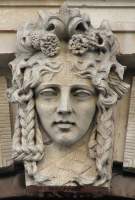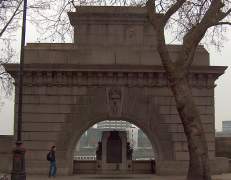
At the top of a round arch is the keystone, which holds the arch together, and on which the weight of the building above contacts the arch and is transferred to right and left. It is therefore symbolical as well as design wise an obvious point for decoration.
Gothic would hardly work if we obscured the top of the arch, so that keystones are almost entirely found on classical buildings. Yet often the keystones recall the gargoyles and decorations of old churches, a harking back to a medievalising tendancy towards profuse decoration and adding a human, personal aspect to a stone building which generally is on a large and inhuman scale, and so rather impersonal - our decorative sculpture adds a human aspect to the building. We might recall pre-industrial African art, where all sorts of objects have a face somewhere, which is the soul or impersonification of the object, and perhaps sometimes our keystones would be the personification of the building. But perhaps this is too fanciful. Back, then, to the simple idea that keystones are for classical buildings, not Gothic.
An important aspect of the keystone is that it can be fairly modest - even small buildings where any ambitious sculpture would be unaffordable, can extend to a decorative keystone. So we find that there are thousands of examples across Britain.
Another characteristic is that keystones are generally anonymous: although there are a few where the sculptor is certain, the vast majority are unknown, and even if on a highly sculptured building the author of the principal sculptural elements is known, it is often the case that there will be no assurance that minor elements such as keystones will have been done by this sculptor. I don't think we should see this as a frustration, but just a characteristic: I like to think that for many masons and sculptors who were never going to achieve the first rank, these keystones offered an opportunity to show that on a small scale, they could produce a work of art of their own. And again thinking back to medieval precedent, it was very unusual indeed for a sculptor to sign his works in all the cathedrals and churches across the land.
A final point before we look at examples: although a keystone is a part of an arch, we often find a flat-topped window has a similar decorative motif in the central position above the window, the 'keystone position' if you will. Although from an architectural point of view there is no equivalence, in decorative terms they are often identical to keystones, so we include a few examples of these too.
The commonest sculptured keystones by far show human faces. And of these, one of the most frequent, and most arresting, is a male, bearded face - perhaps a quarter of all keystones have this motif. The best of these have a long, heavy beard, often rather somewhat like, hanging seaweeds, and so typically of Neptune or some other sea deity. Our first example, below, is on the Victoria Embankment, the George V Arch, and surely this must be one of the largest, if not the largest, example of a keystone we have, comparable in size to the person conveniently walking past it. Loads more examples of bearded keystone heads on this page.

 King George V Arch, Victoria Embankment.
King George V Arch, Victoria Embankment.
Here are a few more of these bearded keystone heads - you will need to click on them to see the details. The first is a personal favorite, with his woebegone shaggy look, and is one of the few where the sculptor is known - it is by John Thomas, and may be found along with other works by him in the Kensington Water Gardens. The next has his forked beard loosely plaited toegher, and two fish forming a crown. Then one with less seaweed-like beard, but long moustaches, again with a fish in his hair, and the rightmost has a shell and a pair of twin-tailed mermaids reclining in his hair. Excellently clammy in feeling.
Ideal Classical female faces are common too, in the classical idiom. For our examples, the first, below left, is another favorite of mine, at Burlington House (the Royal Academy) in Piccadilly. The next is a rather simple female face, included to show how a keystone can be nicely combined with other sculptural adornment, in this case with two spandrel girls symbolical of beauty, gazing at mirrors. Next, an exquisite keystone, with the ideal face perhaps symbolic of the sun, hence the hair, surrounded with vines and flowers across the whole surface. And to the right, a rather grim-faced female again with grapes and other fruit, but this time in a basket on her head, with a festoon across her breast for good measure. Her bust forms the upper part of the extended keystone, and this is a good use of the three dimensional shape.
Back to some male keystones. Classical buildings of course lend themselves to Classical and heathen deities, and our first example below is of a Green Man, a vegetative demigod found on various medieval churches, carved on Tudor buildings, and revived during Victorian times. This one is on a Manchester building. Next, another Manchester example, showing a satyr with goatlike horns, and elongated ears, the whole designed to fill the keystone frame. Then a keystone of another Green Man, in a composition with an open pediment above, containing a second head, a satyr, with knotted fabric at his ears, the rest of the space being filled out with festoons and flying ribbons. Then on the right, a disturbing grotesqued Satyr with his tongue sticking out, this in Gothic style on a Classical arch. Lots more satyrs on this page.
And now for something more exotic, below. A rare veiled girl from Arabic lands - I cannot think of another 19th Century sculpture of a girl veiled like this (as opposed to across the face, as higher up this page) that I have seen in England. Secondly, a tall keystone showing an Egyptian man, with haughty expression, very accomplished, relic of a wave of Egyptian sculpture which emerged several times during the 19th Century, with the discoveries of various antiquities. There are other Egyptian keystones, showing Pharaohs. Next, a highly stylised Oriental man, rather forbidding, in a pale terra cotta with a swirly cartouche border. Finally, above a square window in keystone position, a wild African girl with ostrich plumes, a necklace, and around her an exuberant medley of elephant tusks and horns, a gourd, and some strange parasol.
We end with a couple of examples of keystones with figures rather than faces (more mermaids on this page). They are relatively unusual. The example below left is one of the beautiful mermaids on the Unilever Building. This uses the keystone as a flat panel rather than taking advantage of the three dimensional aspect. By way of a counter-example, our final example is one of a series of charming half-figures in pink terra cotta, on the front of Watts Warehouse in Manchester. Another example of a building in Manchester with interesting keystones is on this page.
Visits to this page from 18 Mar 2012: 18,115
Bearded keystone heads // Female head keystones // Architectural lion heads // Architecture pages // Sculpture pages